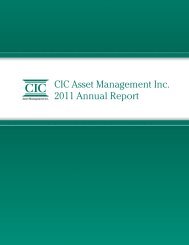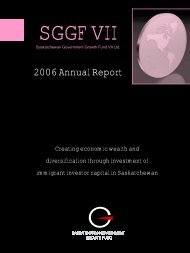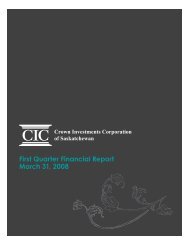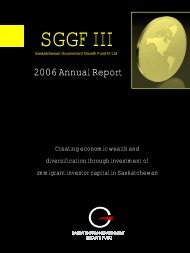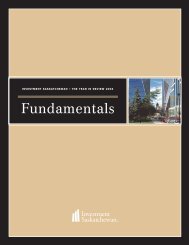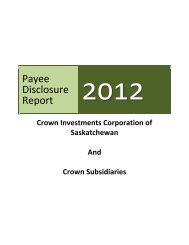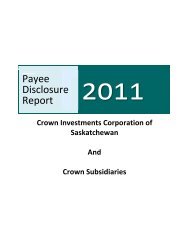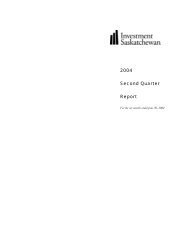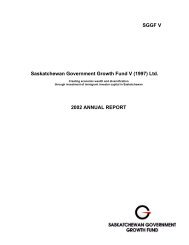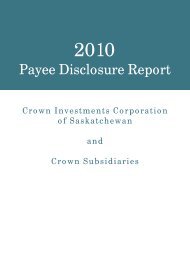2004 Crown Investments Corporation of Saskatchewan Annual Report
2004 Crown Investments Corporation of Saskatchewan Annual Report
2004 Crown Investments Corporation of Saskatchewan Annual Report
Create successful ePaper yourself
Turn your PDF publications into a flip-book with our unique Google optimized e-Paper software.
MANAGEMENT’S DISCUSSION AND ANALYSISManaging Capital Resources in the <strong>Crown</strong> SectorA key priority for CIC is to manage the capital resources within the consolidated group <strong>of</strong> entities to optimizevalue in the <strong>Crown</strong> sector and also provide a return to the GRF. CIC manages this priority through its capitalallocation framework that is developed from two integrated policies. The policies are based on the principle thatthere are three potential uses for cash pr<strong>of</strong>its:Reinvestment in our businesses to sustain infrastructure and operations, to grow and diversify revenues,and support public policy initiatives and economic development;Dividends to the holding company to be used in accordance with the CIC Dividend Policy; andDebt reduction to support the financial flexibility <strong>of</strong> CIC’s businesses.The first policy, the Subsidiary Dividend Policy, focuses on managing capital resources to support the investmentneeds and business viability <strong>of</strong> the various business segments. The second policy, CIC Dividend Policy, ensuresthat the investments into businesses provide a return to the government <strong>of</strong> <strong>Saskatchewan</strong> to support programspaid for from the GRF.Subsidiary Dividend PolicyEach commercial <strong>Crown</strong>’s ability to pay dividends isdetermined after the CIC Board allocates a portion<strong>of</strong> cash pr<strong>of</strong>its to reinvestment and debt reduction.The CIC Board has approved debt and capitalstructure targets for CIC’s subsidiaries based onindustry benchmarks. Therefore, for subsidiariesthat pay dividends, the amount paid is determinedin relation to a business’ target capital structurecompared to actual capital structure.Reinvestment<strong>Crown</strong> <strong>Corporation</strong>Cash Pr<strong>of</strong>itsDividends to CICDebt Reduction ifnecessaryCIC Dividend PolicyIn a similar way, cash paid by subsidiary <strong>Crown</strong>corporations is used by CIC for reinvestment,debt reduction, and dividends to the GRF. CIC,as a holding company, does not have any debt.Therefore, cash is used to pay dividends to theGRF. As well, CIC uses funds to support publicpolicy initiatives, such as providing <strong>Saskatchewan</strong>households with the lowest cost utility bundle.New <strong>Investments</strong>CICCash Pr<strong>of</strong>itsDividend to GRFand Public PolicyExpendituresDebt ReductionCIC’s ability to pay regular dividends to the GRF mainly depends on the level <strong>of</strong> <strong>Crown</strong> dividends to CIC lessCIC’s operating costs. These costs include support to non-dividend paying <strong>Crown</strong> corporations and publicpolicy expenditures. <strong>Crown</strong> dividend levels depend on their net earnings and capital structure. In addition tocash constraints, CIC’s ability to declare dividends to the GRF depends on its retained earnings (a company’sretained earnings are the aggregate amount <strong>of</strong> undistributed income since its inception). CIC’s earnings and,hence, dividend capacity outlook are sensitive to adverse developments in its operating expenditures and <strong>Crown</strong>earnings forecasts.C I C40



